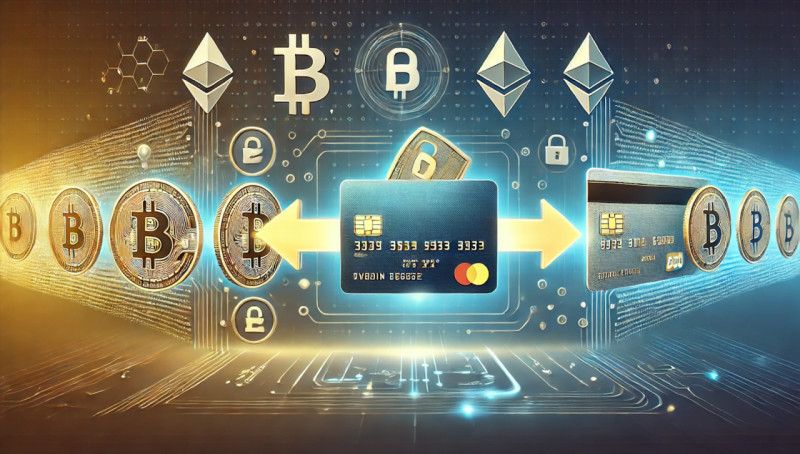
Mastering how to withdraw cryptocurrency is vital in today’s digital economy. While guides like How to Buy Cryptocurrency for Beginners teach the basics, effectively managing digital assets protects funds as well as ensures accessibility. Whether cashing out, securing investments, or preparing for purchases, adopting safe, efficient methods minimizes risks, enhances financial control.
Why Digital Asset Management Matters
Accessing, converting, or safeguarding digital holdings is essential. The freedom digital finance offers comes with responsibilities. Without proper strategies, users face losses, delays, or cyber threats. Several scenarios illustrate the importance of effective management:
- Converting to fiat. Exchanging digital holdings for traditional currencies, such as USD, EUR, or GBP, is common for daily expenses, large purchases, or taxes. Properly managing this process ensures funds reach your account without complications or excessive fees.
- Securing long-term investments. Moving assets offline, such as to hardware wallets, provides protection against phishing, platform vulnerabilities, online threats. Offline storage is crucial for significant or long-term holdings.
- Facilitating relocations. Shifting funds between platforms or wallets is often necessary for better trading opportunities, portfolio diversification, or lower fees. These require careful planning to avoid errors, optimize efficiency.
Each scenario requires technical knowledge, precision, vigilance to prevent costly mistakes.
- Risks, challenges. Managing digital assets involves inherent risks. Comprehending these challenges, preparing effectively ensures smoother shifts along with greater peace of mind.
- Address errors. A single incorrect character in a wallet address can misdirect funds permanently. Blockchain transactions are irreversible, so double-checking details is critical to avoid such errors.
- Fee spikes. Costs on blockchain networks like Ethereum often fluctuate with congestion. High usage increases fees, cutting into relocated amounts or delaying transactions if fees are too low.
- Platform risks. Relying on centralized exchanges or intermediaries comes with potential downsides, including outages, account freezes, or security breaches. Selecting reputable platforms with robust security measures mitigates these risks.
- Regulations. Jurisdictions vary in their rules for transferring or converting digital assets. Ignoring these requirements can lead to fines, frozen accounts, or legal issues. Staying informed about local regulations ensures compliance.
Secure, Efficient Methods
Using secure, efficient practices protects your holdings, minimizes delays or fees. These are key for anyone managing assets:
- Verify details. Double-check wallet addresses, account numbers, amounts. Minor errors can lead to irreversible losses. If unsure, test with a small amount before completing larger moves.
- Optimize timing. Initiate transactions during low network traffic to save on fees. Tools like Ethereum Gas Tracker or Bitcoin Mempool help identify the best times for cost-effective transactions.
- Research platform rules. Platforms have unique policies on limits, processing times, fees. Knowing these ahead prevents surprises, ensures relocations are completed smoothly.
- Use secure connections. Avoid public Wi-Fi, which increases interception risks. If a private connection isn’t available, use a VPN to encrypt traffic, protect sensitive information.
- Enable Two-Factor Authentication (2FA). Adding a second verification step, like a code from an app, significantly reduces risks of unauthorized access to accounts.
Confidence Through Preparation
Managing digital funds involves more than protecting assets—it empowers you to thrive in a rapidly changing financial ecosystem. Mastering how to withdraw cryptocurrency builds confidence for cashing out, securing investments, or exploring decentralized finance. Implementing secure practices, optimizing timing, grasping platform policies ensures smoother processes, minimizes risks.
Taking proactive steps like verifying details, anticipating challenges, following best practices positions you for long-term success. Whether moving funds for immediate use or securing them for future needs, mastering these skills equips you to confidently navigate the dynamic world of digital finance.
Key Considerations Before Withdrawing
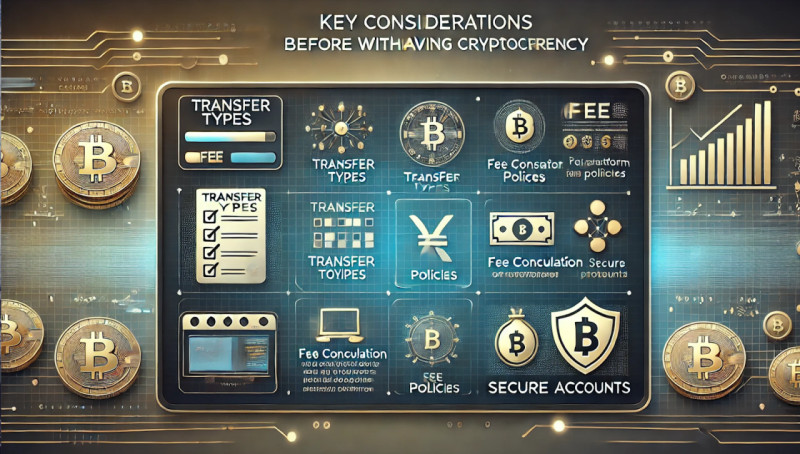
Effectively managing digital funds involves strategic decisions, especially when converting holdings, moving assets, or accessing them for use. Whether you’re exchanging digital currencies for fiat, safeguarding funds offline, or preparing for purchases, careful planning ensures efficiency as well as security. Mistakes during these processes can lead to delays, excessive fees, or even permanent losses. Mastering the withdrawal process minimizes risks, enhances confidence in navigating digital finance.
Knowing Transfer Types
Each conversion serves distinct purposes, involves specific considerations. Defining your objective streamlines the process, ensures secure management.
- Converting to fiat currencies
Exchanging digital funds for traditional currencies, such as USD or EUR, is necessary for everyday expenses, large purchases, or tax obligations. Centralized platforms, including exchanges, manage this process, moving funds directly to linked bank accounts. However, these services charge fees, impose limits, may have variable processing times depending on location or bank policies. Researching these factors prevents unexpected delays or costs.
2. Moving to a new wallet or address
Sending funds to a new address is common for enhanced security or portfolio diversification. For example, shifting assets to hardware wallets protects them from online vulnerabilities. Similarly, moving holdings to other platforms may unlock trading tools or reduce fees. Ensure the receiving wallet supports the specific asset being relocated. Sending unsupported tokens can result in permanent loss—a mistake avoidable with proper diligence.
3. Peer-to-peer transfers
Direct transactions between individuals offer flexibility, are often used for trades or informal payments. Peer-to-peer platforms facilitate these transactions, often with escrow services for added security. Both parties must verify wallet addresses, agree on terms to avoid disputes or errors. For significant amounts, test moves confirm accuracy before completing the full amount.
Navigating Platform Policies
Platforms impose rules affecting how efficiently transactions are processed. Comprehending these policies reduces complications.
- Limits. Platforms often restrict daily or monthly withdrawal amounts. Exceeding these limits may require identity verification or cause delays. Planning relocations in advance avoids these issues.
- Processing times. Completion time varies: blockchain networks like Bitcoin or Ethereum may take minutes or hours, depending on congestion. Bank conversions from exchanges often take multiple business days, especially for international transactions. Anticipating these timelines improves preparation, reduces stress.
- Verification. Platforms may require identity verification for larger amounts, such as government-issued IDs or proof of address. Ensuring your account is fully verified as well as up to date avoids delays during critical transactions.
Managing Fees
Knowing fees associated with moves minimizes unexpected costs, helps retain value.
- Network fees. Blockchain networks charge fees, such as Ethereum gas costs, which fluctuate with traffic. Timing transfers during low activity saves money, prevents delays caused by insufficient fees.
- Platform charges. Exchanges, third-party services impose additional processing fees. Comparing these charges across platforms ensures competitive pricing.
- Hidden Costs. Some services apply extra fees for conversions or offer unfavorable exchange rates. Reviewing terms carefully and knowing how to withdraw cryptocurrency avoids surprises.
Securing Destination Accounts
Ensuring security during transfers prevents errors, unauthorized access.
- Verify compatibility. Ensure the receiving wallet supports the asset being sent. Incompatible relocations often result in irreversible loss.
- Use secure platforms. Choose services with robust security features, such as two-factor authentication (2FA), encryption, device whitelisting.
- Avoid public networks. Public Wi-Fi increases the risk of data theft. Use private connections or a VPN to encrypt activity, reduce exposure to threats.
Addressing Tax Obligations
Tax laws surrounding digital assets vary widely. Compliance protects you from penalties.
- Reporting requirements. Many jurisdictions treat digital-to-fiat conversions or other transfers as taxable events. Gains, losses, non-monetary relocations may require documentation.
- Accurate records. Maintaining logs of moves, including amounts, dates, recipients, simplifies tax reporting. Tools for tracking digital assets improve accuracy, reduce administrative burdens.
Proactive Steps for Smooth Transfers
Taking a few simple precautions avoids common problems, ensures seamless management.
- Verify details: Double-check recipient addresses, amounts. Errors can lead to irretrievable losses.
- Test moves: For high-value amounts, send a small test to confirm accuracy before proceeding with the full transaction.
- Plan ahead: Review platform policies, fees, processing timelines early to avoid surprises.
Empowering Financial Decisions
Mastering the withdrawal process involves more than completing relocations — it’s about safeguarding assets, navigating digital finance confidently. Comprehending transfer types, platform rules, fees, security practices allows for informed decisions that reduce risks, maximize value. Whether cashing out, securing investments, or diversifying holdings, careful planning ensures long-term success in managing digital funds. Take charge of your financial journey by implementing these best practices today.
Methods for Withdrawing Cryptocurrency

Effectively managing digital assets means selecting methods that align with your specific needs. Whether converting holdings into fiat, sending them to secure storage, or making payments, knowing your options ensures smooth as well as secure processes. Mastering the process of cryptocurrency withdrawal is essential for anyone navigating the digital finance world. Below, we explore practical methods to help you manage your funds with confidence.
Using an Exchange
Exchanges remain one of the most widely used platforms for accessing, converting digital funds. Designed with simplicity in mind, they provide intuitive interfaces, features that cater to both new and experienced users.
Steps for using an exchange:
- Log into your account.
- Navigate to the withdrawal section.
- Select the asset you want to access.
- Input the destination address (for wallets) or bank details (for fiat).
- Confirm, wait for processing.
Exchanges often include additional verification steps to enhance security, such as two-factor authentication (2FA). For large withdrawals, identity verification may be required, so having your documents ready can save time.
| Pros | Cons |
| User-friendly, easy to navigate, especially for beginners | Potential vulnerabilities, such as hacks or service outages |
| Allows direct conversion into traditional currencies without extra steps | Daily or monthly withdrawal limits may delay larger relocations |
| Frequent use can lead to accumulating fees |
While exchanges are ideal for quick, straightforward handling of smaller amounts, their security limitations along with fees make them less suitable for long-term or large-scale transactions.
Peer-to-Peer (P2P) Trading
P2P platforms like Binance P2P or LocalBitcoins offer a more direct approach by connecting buyers as well as sellers without centralized intermediaries. This method is particularly useful for those users who want to know how to withdraw cryptocurrency seeking local payment options or flexible terms.
Steps for P2P trading:
- Choose a trusted buyer or seller.
- Agree on terms, including payment method, exchange rate.
- Provide wallet details for sending or receiving funds.
- Verify payment before releasing assets.
P2P platforms often include features like escrow services, which hold funds until both parties meet their agreed conditions. This adds an extra layer of security, reduces the risk of disputes.
| Pros | Cons |
| Competitive rates due to direct negotiation | Requires careful vetting of counterparties to avoid scams |
| Avoids high platform fees typical of exchanges | Trust issues or miscommunication can delay completion |
For users who prioritize flexibility, want more control over payment methods, P2P trading is a solid option. However, thorough verification together with testing with small amounts are critical to ensure secure exchanges.
Using a Digital ATM
Digital ATMs provide immediate access to cash by converting digital holdings into physical money. These machines are particularly convenient for users who need quick, local solutions, do not want to rely on online accounts.
Steps for using a digital ATM:
- Locate an ATM supporting your asset.
- Scan your wallet’s QR code to link funds.
- Confirm the amount to withdraw.
- Collect your cash.
These ATMs often display real-time exchange rates, fees, allowing users to make informed decisions before proceeding.
| Pros | Cons |
| Provides instant access to cash without waiting for online processing | Limited availability in certain regions, especially rural areas |
| Does not require account setup or lengthy verification steps | Fees are typically higher than online methods |
Digital ATMs are excellent for those who need immediate funds, value convenience, though their availability, costs can pose challenges.
Direct Bank Transfers
Platforms like Coinbase or Kraken offer seamless bank integration, making them a reliable option for converting digital assets into fiat. This method is particularly effective for managing larger amounts.
Steps for direct bank transfers:
- Link your bank account to the platform.
- Convert your digital holdings into traditional money.
- Initiate the relocation to your linked account.
Some platforms offer expedited processing for an additional fee, which can be useful for urgent transactions.
| Pros | Cons |
| Reliable, secure, especially for large amounts | Processing can take 1–3 business days, depending on bank policies |
| Bank integration provides an added layer of accountability | Receiving banks may impose additional fees for incoming operations |
Bank transfers are best for users managing substantial holdings who value professionalism, security over speed.
Choosing the Right Method
The best method depends on your specific goals, urgency, conversion size:
- Exchanges: perfect for straightforward, smaller withdrawals.
- P2P trading: ideal for flexible terms, local payment options.
- Digital ATMs: great for immediate cash needs but limited by location.
- Bank transfers: reliable as well as secure for managing large amounts.
Balancing simplicity, cost, security ensures a smooth experience. Mastering the cryptocurrency withdrawal process empowers users to make informed decisions, avoid common pitfalls, protect their assets effectively. By grasping these methods, their nuances, you can confidently navigate the dynamic landscape of digital finance.
Best Practices for Secure Withdrawals
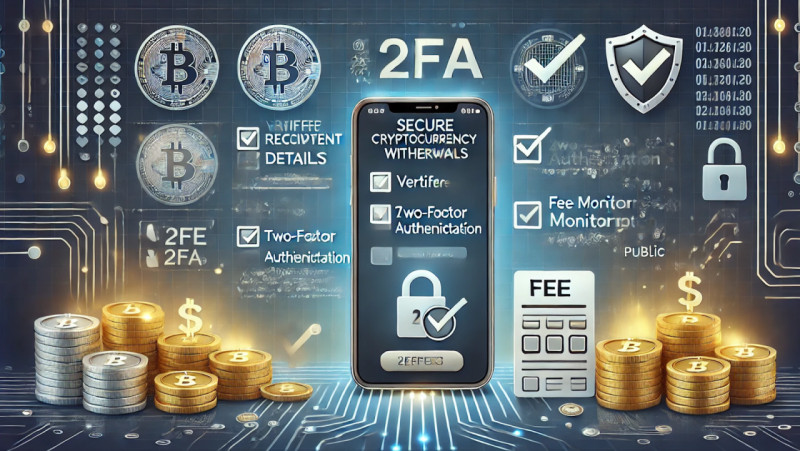
Managing digital holdings requires precision, security, adherence to effective practices. Whether converting funds to fiat, moving them to a secure address, or safeguarding investments, following best practices ensures assets are protected. Mastering how to withdraw cryptocurrency is about more than sending funds — it’s about minimizing risks, streamlining operations.
Verify Recipient Details
Errors in recipient information can result in irretrievable losses. Ensuring accuracy is essential.
- Wallet address verification. Double-check wallet addresses before confirming an operation. Blockchain transactions are final, mistakes cannot be undone. Copy-pasting addresses reduces manual entry errors. Use QR codes when available to avoid typos entirely.
- Bank account validation. When moving funds to a bank, confirm account, routing numbers, along with the recipient’s name. Errors can delay or cancel transactions, especially with cross-border transactions requiring precise information.
- Test moves. Send a small amount first to ensure the recipient’s details, platform functionality are correct. Once confirmed, proceed with the full amount to avoid unnecessary risks.
Even minor errors can have significant consequences. Accuracy is non-negotiable when managing digital funds.
Enable Two-Factor Authentication (2FA)
2FA is a simple yet highly effective tool for preventing unauthorized access.
- Strengthen account security. Activate 2FA on all accounts managing digital holdings. This additional layer of verification, such as an authenticator app code or email confirmation, provides critical protection.
- Move beyond SMS-based 2FA. SMS-based 2FA is more vulnerable to attacks like SIM-swapping. Use apps like Google Authenticator or Authy, which offer more secure alternatives.
- Extend 2FA to destination wallets. Ensure receiving wallets also have 2FA enabled. This reduces risks from tampering, unauthorized access on either end.
By implementing 2FA, you add an essential layer of security to protect your holdings at all stages.
Monitor Fees
Knowing transaction fees, planning accordingly minimizes unnecessary expenses.
- Network fees. Fees on blockchain networks like Ethereum fluctuate based on traffic. Use tools to track congestion, choose off-peak times for lower costs.
- Platform charges. Exchanges as well as services often charge processing fees. Compare platforms to find transparent, competitive rates. Regular users should explore options with volume discounts or flat fees.
- Hidden costs. Be aware of additional charges, like currency conversion fees or expedited processing costs. These can significantly reduce the final amount received.
Monitoring along with managing fees ensures funds are used efficiently, reduces unexpected losses.
Start Small
Beginning with smaller amounts helps verify every step of the process.
- Test relocations. Use minimal amounts when using a platform for the first time or sending to new addresses. This ensures accuracy, prevents larger errors.
- Gauge processing speeds. Small operations reveal how quickly platforms process requests. Knowing these times helps set realistic expectations, especially during peak periods.
Starting with small amounts minimizes risks, builds confidence in your processes.
Avoid Public Networks
Unsecure connections are a common weak point. Prioritizing secure networks keeps your data safe.
- Secure connections only. Conduct all activities involving digital funds on private, secure internet connections. Avoid public Wi-Fi, which increases interception risks.
- Use a VPN. A Virtual Private Network encrypts your activity, providing an additional security layer when accessing digital holdings on the go.
By taking these steps, you protect sensitive information from potential breaches.
Stay Updated on Regulations
Compliance with local laws ensures your activities remain legitimate, avoids penalties .
- Know your country’s rules. Regulations for how to withdraw cryptocurrency vary globally. Some jurisdictions require reporting gains, while others impose strict conditions for converting funds into fiat. Grasping these rules prevents complications.
- Monitor changes. The legal environment is constantly evolving. Stay informed through reliable sources or seek professional advice to navigate shifting requirements.
- Maintain records. Detailed logs of transactions, including dates, amounts, recipients, simplify tax reporting, provide documentation for audits.
Staying compliant with regulations safeguards your financial activities, ensures peace of mind.
Building Security Into Every Step
Managing digital holdings effectively means combining security along with precision. Verifying details prevents costly mistakes, implementing 2FA secures accounts, monitoring fees minimizes expenses. Starting with small amounts reduces risks, while avoiding public networks ensures data safety. Staying informed about regulations adds another layer of protection.
By incorporating these best practices, you create a robust framework for managing digital funds confidently. These steps protect assets, streamline processes, empowering secure as well as efficient participation in the digital economy.
Common Issues, How to Solve Them
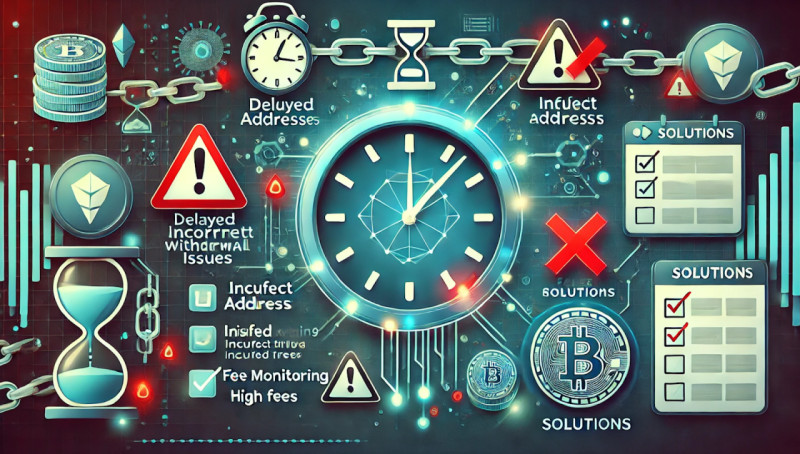
Managing digital assets involves potential challenges, from delays to lost funds as well as unexpected fees. Knowing these common issues, preparing effective solutions ensures a smoother, safer process. Mastering the process of withdrawal is about more than moving funds—it’s about safeguarding assets, ensuring a stress-free experience.
Delayed Transfers
Delays can be frustrating, especially when timing is crucial. Knowing the causes, solutions minimizes stress, helps you plan better.
Causes:
- Network congestion: popular blockchains like Ethereum or Bitcoin slow during high activity periods, increasing confirmation times.
- Platform delays: centralized services like exchanges often hold transactions for compliance reviews, especially for large amounts.
Managing Delays:
- Track status: Use blockchain explorers like Etherscan to monitor your operation. Enter your transaction ID to see its current state.
- Contact support: if delays occur on a platform, contact support with transaction details. Some delays may result from internal processing, support can clarify or expedite the process.
- Plan relocations: perform operations during off-peak hours to avoid network congestion. Tools like fee trackers help identify quieter periods.
Planning moves with timing, network conditions in mind reduces waiting times along with frustration.
Incorrect Address
A wrong recipient address is one of the most serious errors, often leading to permanent loss of funds. Blockchain transactions are irreversible, so accuracy is critical.
Consequences:
- Permanent loss: funds sent to an unintended address can only be recovered if the recipient willingly returns them.
- Incompatibility issues: moving assets to unsupported wallets, such as sending Bitcoin to an Ethereum wallet, typically makes the funds inaccessible.
Prevention, solutions:
- Double-check entries: verify wallet addresses carefully before confirming a relocation. Use copy-paste to avoid typos, scan QR codes when possible to eliminate errors.
- Test small amounts: send a small amount to confirm accuracy, especially when dealing with large sums. This provides peace of mind before committing the full amount.
- Seek platform help: if the issue involves wallets within the same platform, contact support immediately. Some services may assist in recovering misplaced funds.
Taking extra time to confirm details can prevent irreversible mistakes, protect your assets.
Failed Transfers
Failed relocations may occur due to technical glitches, insufficient balances, or unsupported assets. Grasping why they happen as well as how to withdraw cryptocurrency correctly helps prevent future issues.
Why operations fail:
- Insufficient funds: not enough balance to cover both the amount and associated fees is a common cause of failure.
- Platform glitches: temporary errors or network issues can disrupt processing.
- Incompatibility: Sending unsupported tokens or using incorrect formats can result in failure.
Troubleshooting:
- Check balances: ensure you have enough funds for both the transaction and fees. Double-check all amounts before initiating.
- Retry later: platform or network glitches often resolve after a short wait.
- Contact support: if retries fail, provide the platform with detailed information, including error codes, to resolve the issue.
Being prepared, verifying details reduces the chances of relocation failures.
High Fees
Unexpected fees can reduce the value of your operation, particularly during periods of high demand. Managing these costs ensures more efficient transactions.
Common fee issues:
- Variable blockchain fees: networks like Ethereum charge fluctuating fees based on activity levels.
- Service fees: platforms may impose additional charges for processing transactions or conversions.
- Hidden costs: currency conversions, other platform-specific charges can further erode your funds.
Reducing costs:
- Monitor fees: tools like ETH Gas Station or Bitcoin Mempool provide real-time insights into blockchain activity, helping you time moves during low-demand periods.
- Research platforms: compare fee structures to find services with transparent as well as reasonable pricing.
- Batch transfers: when possible, consolidate smaller amounts into a single larger one to save on cumulative fees.
Knowing fee dynamics, choosing optimal times to send funds maximizes the value of your holdings.
Avoiding Common Issues
Proactive steps prevent many of the common challenges users face when managing digital funds.
Steps for success:
- Verify details: double-check all wallet addresses, amounts. A single mistake can lead to irretrievable loss.
- Monitor network conditions: use tools to track blockchain activity, plan moves during quieter times.
- Grasp platform rules: research platform-specific policies, such as withdrawal limits or processing times, to avoid surprises.
- Use secure connections: avoid public Wi-Fi, use private, encrypted networks to prevent data interception. A Virtual Private Network (VPN) adds extra security.
Staying vigilant, prepared ensures smoother transactions, protects your funds.
Building Confidence in Transfers
Mastering the process of withdrawal involves more than just moving assets. It’s about protecting holdings, avoiding errors, ensuring seamless processes. While challenges like delays, incorrect addresses, high fees are common, they are manageable with preparation, the right tools. By verifying recipient details, monitoring fees, using secure connections, you reduce risks, gain confidence in managing digital finance. These proactive strategies safeguard your assets, streamline your experience, empowering you to navigate the digital economy with ease.
Frequently Asked Questions
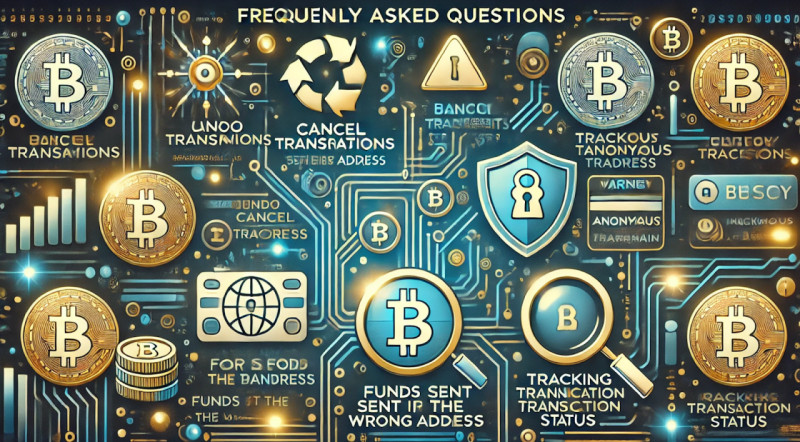
Managing digital assets requires comprehending potential challenges along with solutions. Answering common questions about the withdrawal of digital assets helps reduce risks, ensures smooth processes. Below are detailed answers to frequently asked questions, along with practical advice.
How Long Does It Take to Access Digital Funds?
Transfer times vary by platform, operation type, network activity.
- Blockchain networks. Conversions on decentralized networks like Bitcoin or Ethereum depend on miner availability as well as congestion. Peak usage can delay confirmations for minutes or hours. Higher fees often prioritize processing for those who know how to withdraw cryptocurrency effectively.
- Centralized platforms. Exchanges or financial apps include steps like security reviews or manual checks for large amounts. Bank transfers for fiat conversions take 1–5 business days depending on banking systems, country regulations. International operations may require extra time due to compliance checks.
- Speed-up tips:
- Pay higher blockchain fees to expedite processing. Use fee trackers to calculate optimal fees.
- Schedule conversions during low-traffic periods to avoid network congestion.
- For bank operations, choose platforms offering faster payout options or same-day services.
Comprehending these factors ensures better planning, reduces delays.
Can a Transaction Be Canceled Once Initiated?
Canceling an operation depends on the platform, confirmation status.
- Blockchain moves. Confirmed blockchain transactions are permanent due to the technology’s immutability. Pending operations may allow fee adjustments to expedite or cancel incomplete transactions, but this varies by platform.
- Centralized platforms. On exchanges, pending withdrawals may be canceled during processing. Policies differ, so act quickly, consult support if cancellation is needed.
- Prevention:
- Double-check wallet addresses, amounts before confirming.
- Use small test conversions to confirm details before initiating larger amounts.
Careful planning prevents errors, avoids irreversible mistakes.
What Happens if Funds Are Sent to the Wrong Address?
Sending funds to an incorrect address is a serious error. Blockchain transactions are final, recovery depends on specific circumstances.
- Address errors:
- Invalid addresses cause transactions to fail, leaving funds in your account.
- Valid but unintended addresses often result in permanent loss unless the recipient voluntarily returns funds, which is rare.
- Recovery steps:
- Contact the platform’s support team immediately if funds were sent within their system. Some platforms assist with recovery for internal moves.
- If the recipient is known, request a return. For unknown recipients, recovery is unlikely.
- Prevention:
- Use QR codes to reduce manual entry errors.
- Always verify addresses, consider a small test transfer before sending large amounts.
Taking these precautions ensures fewer errors, protects your assets.
Are Transfers Anonymous?
The anonymity of operations depends on the network and platform.
- Public blockchains. Networks like Bitcoin or Ethereum are pseudonymous, showing wallet addresses publicly without directly revealing owner identities. However, using wallets linked to exchanges compromises privacy.
- Centralized platforms. Exchanges requiring identity verification remove anonymity, tying transactions to user accounts.
- Privacy options:
- Networks like Monero or Zcash prioritize anonymity by masking transaction details.
- Mixing services can anonymize transactions but may face legal or ethical restrictions.
Knowing privacy levels helps users decide which platforms align with their goals.
How Can You Track the Status of an Operation?
Tracking transfers provides reassurance, resolves uncertainties.
- Blockchain explorers. Tools like Etherscan (Ethereum) or Blockchain.com (Bitcoin) allow users to input transaction IDs to check progress. Confirmations indicate how far along a relocation is, with platforms often requiring multiple confirmations.
- Platform notifications. Exchanges as well as apps notify users via email or SMS when transactions are initiated or completed. Ensure notifications are enabled for real-time updates.
- Support Assistance. If tools lack clarity, contact platform support. Provide transaction IDs or error codes for quicker help.
Tracking ensures transparency, helps address delays effectively.
Maximizing Confidence in Transfers
Answering these questions reduces uncertainty, helping users master how to withdraw cryptocurrency confidently. Knowing typical operation times, preventing address errors, knowing privacy options, tracking progress minimizes risks.
Preparation is essential: double-checking details, using test moves, comprehending platform policies reduce mistakes. By mastering the withdrawal process, users ensure smoother processes, safeguard assets, gain confidence in digital finance. Proactive decisions as well as informed planning create a foundation for secure, efficient financial management.
Conclusion
Effectively managing digital assets involves more than knowing every step of the withdrawal process. Choosing methods that align with specific needs ensures secure processes, protects investments. Decisions about converting digital assets to traditional currencies, securing funds offline, or making payments require careful planning to minimize risks, optimize outcomes.
Importance of Tailored Methods
No single method suits every situation. Tailoring your approach to specific goals ensures efficiency as well as security.
Converting to Fiat
For those accessing traditional currencies like USD or EUR, exchanges are common solutions. Platforms such as Coinbase or Binance offer streamlined processes but vary in fees along with speed. Choosing a platform that matches your priorities — low fees, fast payouts, or ease of use — helps maximize the value of your funds.
Transferring for Security
Protecting digital assets often involves moving them to hardware wallets or offline storage. These solutions safeguard against hacking, online threats but require precision. Always verify compatibility with the destination wallet, double-check details. Sending funds to an unsupported wallet can result in permanent loss.
Peer-to-Peer Transaction
Direct relocations via platforms like Binance P2P or LocalBitcoins allow users to bypass intermediaries. While these methods provide flexibility, direct negotiation, they require vetting of recipients. Miscommunication or errors may lead to disputes or losses. Testing with small amounts before larger amounts adds a layer of safety.
Each scenario benefits from thoughtful planning. Whether your priority is speed, security, or customization, aligning your method with your goals simplifies processes, reduces risks.
Prioritizing Security, Accuracy
Sending digital funds requires a strong focus on security along with accuracy. Even small mistakes can lead to significant consequences, making vigilance essential.
Strengthening Security
- Use unique, complex passwords, enable two-factor authentication (2FA) for all accounts.
- Avoid public Wi-Fi for sensitive actions; if necessary, use a Virtual Private Network (VPN) to encrypt connections, enhance privacy.
Ensuring Accuracy
- Double-check wallet addresses, amounts. A single error can result in irreversible loss.
- Use QR codes to minimize manual entry errors.
- Test moves with small amounts to verify processes before completing larger transactions.
Security along with accuracy aren’t optional—they’re critical for protecting assets, ensuring smooth managing.
Staying Compliant with Regulations
Compliance with local laws ensures smooth management of digital holdings, prevents penalties. As regulations evolve, staying informed is crucial.
Tax Obligations
Many jurisdictions require reporting gains or losses from converting digital funds to fiat. Keeping detailed records — including transaction amounts, dates, purposes — simplifies tax filing, ensures compliance.
Adapting to Legal Changes
Digital finance regulations change frequently. Stay informed via reputable news sources or consult professionals to align practices with current laws. Noncompliance risks fines or account freezes, making awareness essential.
Remaining compliant safeguards your financial activities, builds confidence in managing assets responsibly as well as understanding how to withdraw cryptocurrency without any problems.
Actionable Steps for Safe Transfers
To manage digital assets effectively, adopt these strategies:
- Assess your needs: clarify whether converting funds to fiat, securing them offline, or making payments is your goal.
- Choose the right platform: evaluate exchanges, wallets, or P2P platforms for fees, speed, security features.
- Prepare thoroughly: double-check recipient details, monitor network activity, know platform policies.
- Stay educated: digital finance evolves rapidly. Regularly learn about tools, security measures, regulatory updates to minimize risks.
Empowering Your Financial Journey
Taking control of digital funds is about securing your financial future. Mastering the withdrawal process of digital assets minimizes risks, protects investments, ensures smooth management. Whether securing assets for long-term use or managing immediate needs, following best practices builds confidence in navigating digital finance.
Proactive decisions along with informed strategies optimize your financial journey. Start applying these methods today to protect, grow your digital assets.
Recommended
How to Mine Cryptocurrency on PC
How to Mine Cryptocurrency on iPhone
How to earn interest on cryptocurrency
How to invest in cryptocurrency
















